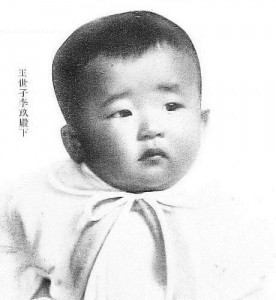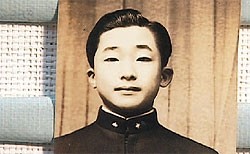Yi Ku, the Last Prince of the Joseon Dynasty
The Korean diaspora community that emerged in Boston in the mid-twentieth century had a connection to the sad story of the collapsed Korean Joseon Dynasty. Yi Ku, the son of Crown Prince Yi Eun and grandson of the Korean Emperor Kojong, studied architecture at the Massachusetts Institute of Technology from 1953 to 1957.[1] If Korea had not fallen to the colonial rule of Japan in 1910, or if Korea had restored its monarchy after independence in 1945, Yi Ku would have ascended to the Korean throne.

Yi Ku’s entire life reflected the distorted modern history of Korea. He was born in Tokyo, Japan, in 1931, when Korea was ruled by that country. His father, the Crown Prince Yi Un, was brought to Japan in 1907 and forced to marry a Japanese princess, Masako Nashimoto (also known by the Korean name, Yi Pangja), in 1920. Officially, this marriage was arranged by the Japanese Imperial Household Ministry to strengthen the ties between Korea and Japan by a royal marriage.[2] There were widespread rumors, however, that she had been diagnosed to be barren and this marriage was arranged by the Japanese colonial government to end the Korean royal line.[3] Nevertheless, Pangja gave birth to two sons, Chin and Ku. The first son, Yi Chin, born in 1921, died suddenly during a visit to Korea when he was only eight months old. The cause of death was ruled to be acute dyspepsia caused by milk, but there were widespread rumors that he had been poisoned. In her autobiography, Pangja raised these suspicions about the cause of her son’s death. She wrote, “The milk we gave the baby, to supplement breast feeding, might well be suspect, but could that milk be so poisonous as to cause a fatal condition in so short a time? If the milk was really bad, my baby should have been ill from the beginning of his stay in Korea.”[4] Ten years later, the royal couple gave birth to their second son, Yi Ku, who would become the last official crown prince of the Korean royal family. Afraid of losing another child, Yi Ku’s parents never took him to Korea during their annual trips to pay homage to their ancestral tombs and to visit relatives.[5]

Growing up in Japan as a hostage, Prince Ku dreamed of studying abroad, but until the defeat of Japan in 1945, he was not allowed to leave that country. Even then, Yi Ku had a hard time obtaining a passport from the newly founded Republic of Korea. Yi Seungman, the first president of the Republic of Korea, was reluctant to issue passports to Korean royalty living in Japan out of fear that they might spark a restoration movement. With the aid of Kim Yongjung, the Ambassador of the Republic of Korea to Japan, however, Yi Ku finally obtained a passport.[6] According to some reports, it was issued on the condition that he would not act as a prince in the US. Whatever the case, Yi Ku departed for the U.S. on August 3, 1950, shortly after the start of the Korean War.[7]
It is not clear what high school he attended in the U.S, but Yi Ku enrolled at M.I.T. in 1953. While a student, he worked in a laundry to earn money. Raised in Japan as royalty, but not accorded royal status by his fellow Koreans, he found himself in an unusual position while in the U.S. According to Dr. Ko Hyeseong, students from Japan, where a constitutional monarchy was retained even after the defeat of World War II, would not bring clothes to Yi Ku out of respect for his royal status. Koreans, however, did not show him that same respect.[8] While a student in in the Boston area, he faced another difficulty when his passport expired and the Korean Embassy in the U.S. refused to renew it. This time with the help of Japanese and American friends in Boston, he became a permanent resident in the United States in November 1956.[9] The unfavorable attitude of the Korean government to the fallen dynasty was also demonstrated when Yi Ku graduated from M.I.T. in 1957. At that time, the Korean government refused to issue a passport to Yi Ku’s father. In order for his parents to travel to the U.S. to celebrate, Yi Un renounced his Korean citizenship to obtain a Japanese passport.[10] Recollecting these events, Pangja wrote, “[Yi Ku] was neither Korean nor Japanese, as neither country had supported him. He has overcome his difficulties alone and become a man of the world.”[11]
Dr. Ko discusses her memories of Yi Ku, the last heir of the Korean Joseon dynasty, during his time in Boston. |
|
Like other Koreans pursuing higher education in Boston at the time, Yi Ku was preparing to take on a leadership role in a newly independent Korean nation or in his adopted home, the United States. After his graduation, Yi Ku went to New York and worked as an architect with I. M. Pei until 1963. While in New York, he married Julia Mullock, a Ukrainian-American woman eight years his senior, on 23 October in 1959.[12] Yi Ku finally visited Korea in 1963, with the help of the new President Park Chung-hee. President Park had obtained power through a military coup and wanted to take advantage of the Yi family to secure his legitimacy. While in Korea, Yi Ku lectured on architecture at Seoul National University and Yonsei University and also ran his own architecture company, Sinhan.
Several obstacles prevented Yi Ku from adjusting well to life in Korea. First, although Korea was no longer a monarchy, he was pressured by his family to take on the role of “crown prince.” His marriage to a white woman and their inability to have children intensified the pressure. As a result, their marital life suffered. Second, he was not fluent in Korean and did not understand Korean culture well. In 1977, Yi Ku and his wife separated. When his company went bankrupt in 1979, he returned to Japan. In 1982, the couple divorced, and Yi Ku started living with a Japanese astrologer, or mudang, named Mrs. Arita.[13]
The former prince visited Korea from time to time until his death in 2005, at the age of seventy-four. He died alone at the Akasaka Prince Hotel, the former residence of his parents in Tokyo. Yi Ku was buried in royal garb, and over 1,000 people, including the Prime Minister of Korea, attended his funeral. After his death, he was granted the posthumous title “Prince Imperial Hoeun of Korea” by the Yi Family Council.
Citations
[1] This article follows the South Korean Ministry of Culture system of Romanization unless cited source material follows an alternate system.
[2] Yi Pangja, The World is One: Princess Yi Pangja’s Autobiography (Seoul: Taewon Publishing, 1973), 93.
[3] Interview with Dr. Ko Hyeseong Chun.
[4] Yi, 108.
[5] Ibid., 138.
[6] The New England Centennial Committee of Korean Immigration to the United States, ed., History of Koreans in New England (Seoul: Sunhaksa, 2004), 59-60.
[7] “Yoonsok Park, “Yi Gu, the last Prince of Korean Dynasty,” Sindonga, December, 1996, 385-6.
[8] Interview with Dr. Ko Hyeseong Chun.
[9] Yi, 173.
[10] New England Centennial Committee, History of Koreans in New England, 60.
[11] Yi, 175.
[12] Ibid., 178.
[13] Park, 382.
Written by: Hye Jin Lee
Edited by: Doug Tzan